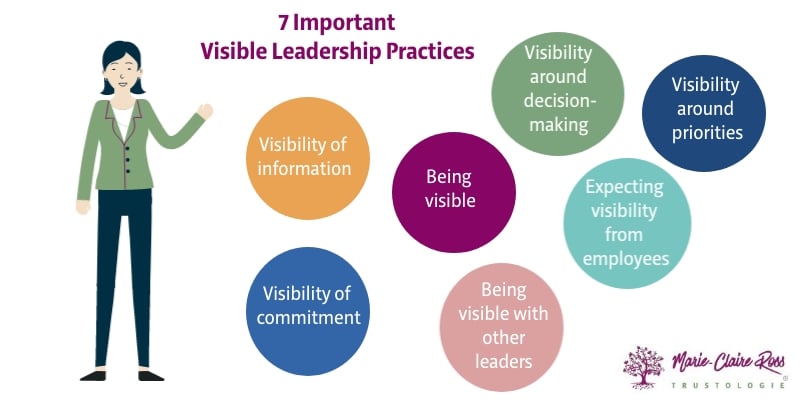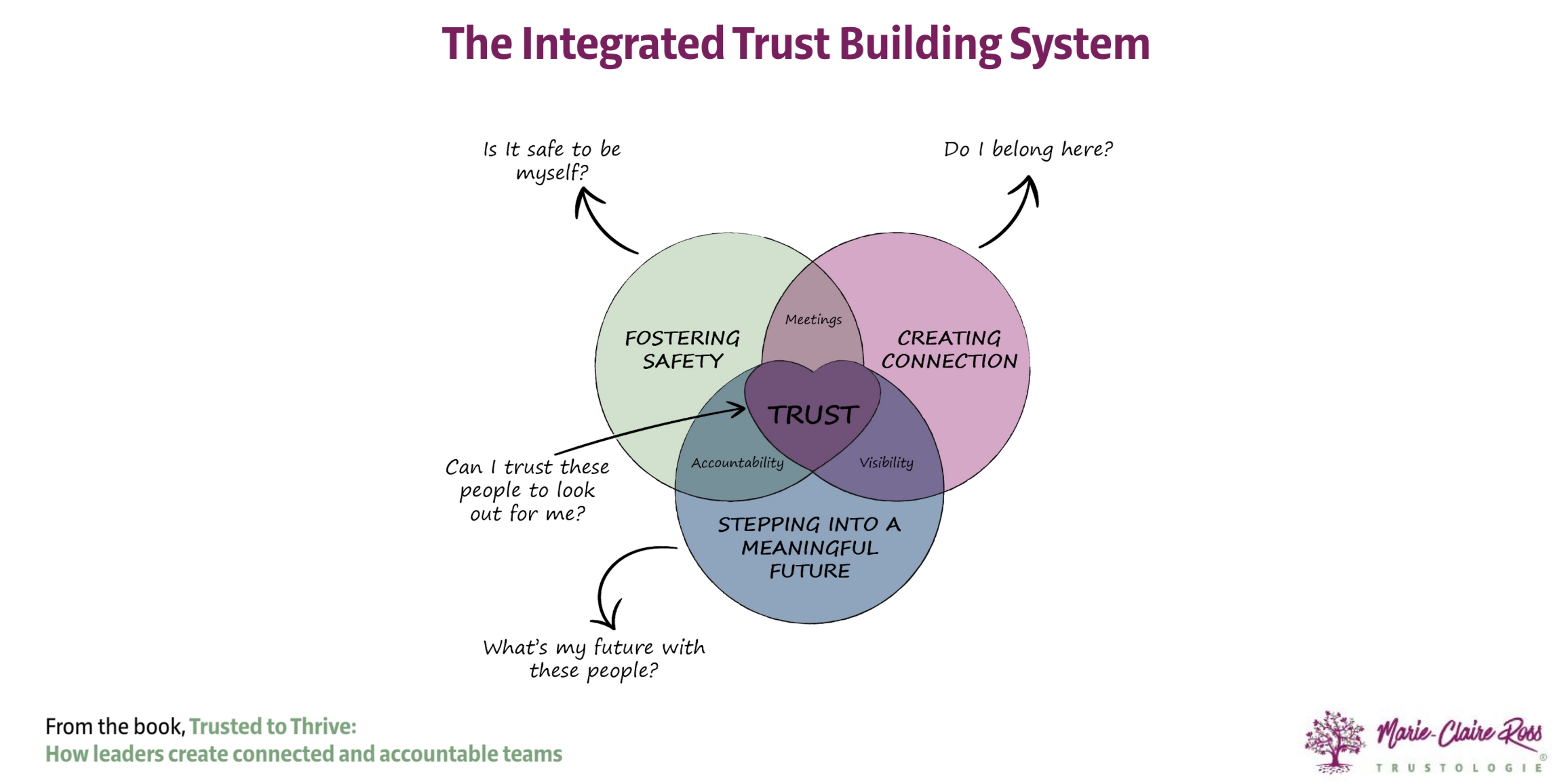
6 Ways to Increase Visible Leadership in the Workplace
In my Integrated Trust Building System, that gets unpacked in the book, Trusted to Thrive, at the intersection between connection and meaningful future, we have visibility. Being a trusted leader boils down to visibility.

Visibility is key to building trust and ensuring accountability and safety. People believe what they can see. Employees need to observe that they are in a safe place – where there are no secrets, their boss is supportive and people aren’t going behind their backs. And that leadership cares about employees.
In the work I do within organisations, teams that feel that leadership is visible and approachable tend to be more collaborative. They are also more motivated to solve problems and love their job.
Often, a lot of leaders believe that visible leadership is about being seen. It's only one part of the equation. Leadership visibility also means making information and work more visible for those both in, and outside, their team. Let’s unpack six visible leadership examples that I talk about in my detail in my book, Trusted to Thrive: get a free chapter)
1. Visibility of information
A major contributor to distrust is when people feel that information has been hidden from them. Ensure that you share as much information as possible (including sources) with your team members. It can be easy to forget to share, making people in your team feel left out. This is particularly the case when you have hybrid teams with some people working in the office and others at home.
Make it a general rule to be as transparent as possible, in order to provide the right context for people.
Share meeting notes, send regular updates and ensure all tasks and expectations are clearly documented. The underlying message is that you are really letting people know that you notice and value them.
2. Visibility around decision-making
Transparency around decisions is critical for any sort of change. Ensure that any leadership decision you make takes your people into account (or provides evidence you went into bat for them). Talk people through how decisions were made. It might seem boring to you, but a lot of employees like to see how decisions were made. Not only does it help them make decisions in alignment with the organisation, but it makes them feel more confident in the leadership direction.
A common complaint is low trust leaders make decisions that don’t consider how it will impact employees. Whether you are making a decision as part of a leadership team or deciding on your interactions with direct reports, always ensure you are putting people first and not results.
3. Visibility around priorities and accountabilities
In today’s interdependent environment, a lack of information sharing actively prevents teams from talking to each other, assembling a full picture and being responsive. It also contributes to silo thinking and working.
If your team or department serves other internal customers, you can often receive more work than you can handle. When your workload increases, it becomes difficult to deliver work on time and to standard, resulting in other teams not trusting your team to deliver.
It is important to improve visibility and communication around the priority of projects and the progress and clarification of work going forward. This helps other teams understand your capacity and reduces tension around resourcing. Be transparent that you will put their work at the back of the queue if additional work appears from the CEO.
Likewise, for a big complex project, it’s important that stakeholders know who to speak to about a problem or service. Otherwise, it creates a perception that your team don’t want to be accountable or aren’t talking to one another.
Visibility of prioritisation and accountability helps employees not only in your team, but also in other teams. It works to provide a common or shared understanding that also provides efficiencies.
4. Being visible
This is an obvious one - but it has a few layers to it. And the one I find leaders forget about is that visibility also means being approachable.
Meetings and one-on-ones are high quality interactions that build trust with those around you but it’s also important that you are visible and approachable outside of those dedicated times.
One of the biggest requests I get from employees when I am doing stakeholder interviews is that they want leaders to, ‘Just say hello. Ask questions about what people are working on. Be human.’ Small interactions make a big difference to employees and must become a weekly structured part of the work leaders do.
Schedule dedicated times each day when people can call you and get an immediate response. Or let employees know that if they mark their email as a high priority you will respond to it that day. Employees love to see their leaders and have some form of interaction. Particularly leaders who are running big departments.
Furthermore, take up opportunities to be more widely visible within your organisation. Employees like to regularly see both the CEO and senior leaders publicly talking about the vision. Town halls or leadership roadshows are ideal for employees to learn about where the organisation is heading and can ask questions.
This technique is not just applicable to senior executives. It’s also relevant for team leaders and managers. Put your hand up for opportunities to speak to more broadly to your workforce.
5. Be visible with other leaders
Employees are always watching how other leaders interact with each other. They take their behavioural cues from these interactions, which has a big impact on whether an organisation has separate silos. Ensuring people feel connected to one another also requires showing visible evidence that leadership talk to one another. People are subconsciously checking out leadership behaviours and looking for information that all is well. Reduce the bias people have to assume the worst by championing transparent, visible practices.
What they want to see is that you are aligned with other leaders and in agreement: around prioritising work, communicating the same vision and working to the same high standards in order to better serve end users. If employees don’t see that, they will decide that the leaders don’t trust one another. This will impact employees all the way down to the front line. Misplaced loyalty to their boss will mean they tend to not collaborate with other teams because they notice their leader holds back from doing so.
One curious thing that I found when I was working with a large organisation was that employees had a perception that senior leaders didn’t like or trust each other. It was based on not seeing much interaction. My advice was that the leaders very loudly pick up the phone and talk to their peers or be seen having corridor conversations. It made a massive difference.
6. Expect visibility from employees
Remote teams are less likely to recover from team members who are not trusting or trustworthy. Of course, if leaders are required to be visible, so are employees. One of the biggest issues with employees working from home is that it is hard for leaders to trust people to work when they can’t see them. Not only that, it’s also hard for their colleagues to trust them, as well.
In weekly team meetings, encourage each team member to talk about their progress to help everyone understand their contribution to the team. Make each individual responsible for gathering this information and presenting it. This is important because we only trust colleagues who are competent at their job. Encouraging each member to prove their competency will help others trust them.
On that note, all Zoom or Teams meetings with colleagues should involve cameras. Having worked with organisations around the world during the pandemic, I have found that organisations that enforced cameras had much more cohesive, high trust cultures. Teams that prefer to keep their camera off will always struggle to build trust remotely.
The Importance of Visible Leadership
With employees working remotely, the need to improve visible leadership is more important than ever. Use these techniques to not only improve your career success, but to increase the likelihood your direct reports feel safe and motivated.

-1.jpeg)